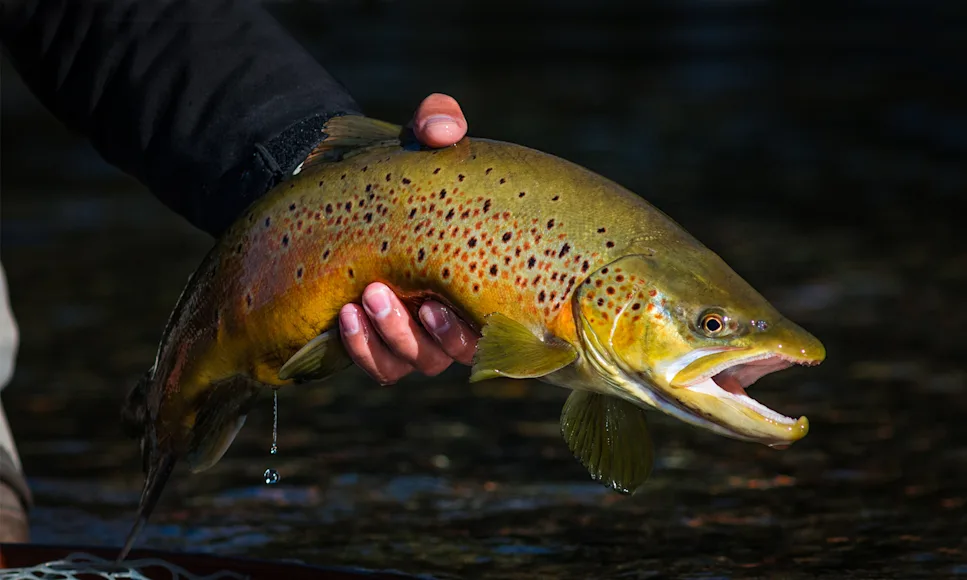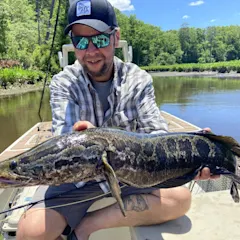We may earn revenue from the products available on this page and participate in affiliate programs. Learn more ›
Streamer flies can mimic a variety of forage, but none is more common than baitfish. Unlike dry flies that match floating insects, and nymphs that look like aquatic insects in their larval stages, streamers are designed to fool trout looking for a bigger meal that packs plenty of protein.
Streamer fishing, however, is a vastly different style of presentation from casting patterns that imitate small bugs. The game with dry flies and nymphs centers around getting a natural, drag-free drift. Streamers, meanwhile, need to be brought to life by the angler by using retrieval techniques and working the rod to get them moving. They are more akin to lures you’d use with conventional tackle than what many people think of as traditional trout flies.
Streamer fishing requires a bit more work, but it can pay off huge—particularly in the early spring and fall when aquatic bug life is minimal. These days, there is no shortage of fly tyers helping to popularize the use of modern, oversized streamers for trophy fish. However, there are lots of classic streamer patterns that require far less specialized gear and have been catching giant trout for decades. Whether you’re fishing on foot or from a drift boat, here are the basics of making streamers work for you.
Table of Contents
Streamer Fishing Gear
Weighted vs Unweighted Streamers
Essential Streamer Flies for Trout Fishing
Streamer Fishing Tips
What Fly-Fishing Gear Do I Need for Streamer Fishing?

The patterns and techniques presented here are all compatible with a 9-foot, 5- or 6-weight fly rod and reel, which are standard sizes for most trout pursuits. If you already fish dry flies and nymphs, you likely have the perfect outfit already. Your reel is also likely loaded with floating fly line. That’s OK, too. Whereas many advanced streamer tactics call for specialty sinking lines, they are not necessary to be successful with these flies. You may, however, consider purchasing a short, removable sink tip. These pre-made sections of weighted line easily connect to the end of your floating fly line, and they help your streamer get down into the strike zone faster. They’re so easy to add or remove that they can be swapped in for a deep run and then quickly taken off at the next shallow riffle.
Weighted vs Unweighted Streamers
Many streamers feature weight to help them sink faster. This can be in the form of lead dumbbell eyes, a metal conehead, or lead wire wrapped around the hook shank under the material. The two key things to understand about weighted flies are that they move with a jigging action when you strip your line, and if you pause your retrieve, they’ll fall instead of hovering in place.
Unweighted streamers usually perform best with a short sink tip, as they won’t sink very quickly on their own. When retrieved, however, unweighted flies twitch, jackknife, and hover in the water column more like a hard-plastic jerkbait. Both styles of fly are highly productive, and you should always carry a few of each. Speaking of which....
5 Essential Streamer Patterns
Like fishing lures, the number of streamers available today is staggering. The truth, though, is that if you have these five on hand, you can catch any trout anywhere. My top picks include tried-and-true classics with a few modern ringers.
Zonker
This simple baitfish imitator has been around for nearly a century. It features a weighted core to help it get down while the rabbit strip material wiggles and flows seductively.
Sparkle Minnow
This new-school pattern has a chubby profile and loads of flash. A conehead amps its jigging action, and big trout can’t resist the pulsing and breathing of its marabou feather tail.
Wooly Bugger
One of the most effective streamers ever tied, these flies are available weighted and unweighted, and in a wide range of colors to match a wide variety of prey species.
Brushy Baitfish
These small, unweighted minnow imitators dart widely and hover in place on the pause when fished with a short sink tip on the end of your floating line.
Bunny Muddler
Combining the features of a classic Muddler Minnow and a Zonker, this conehead fly gets down fast and pushes a lot of water on the strip.
Tips on How to Fly Fish with Streamers

At the base level, making a streamer come to life is easy. You move it by letting it swing in the current or by stripping it in, or both. You can alter the speed of your stripping and ramp up the action even more with snaps and twitches of the rod tip. There are, however, a few nuances that novice streamer anglers might not consider. As subtle as they may seem, they’ll greatly increase your odds of success.
1) Keep the Rod Low
Whether you’re on a boat or wading, get in the habit of retrieving a streamer with your rod tip low. In fact, I like to keep my rod tip a few inches under the water. Not only will this rod angle stop your streamer from rising to the surface and out of the zone, but it also puts you in a better position for a solid hook set, which leads to the next critical tip.
2) Don’t Raise the Rod When You Strike
If you do a lot of nymphing and dry-fly fishing, you’re used to lifting the rod in the air to set the hook after a strike. In streamer fishing, however, this move will cost you a lot of fish. Quite often, a trout is still moving toward you after it eats your streamer, so a lifting set will just pull the fly right out of its mouth. It takes a little muscle training, but get in the habit of continuing to strip after your streamer gets eaten. After you come tight on the strip, then you can raise your rod to fight the fish.
3) Let the Current do the Work
How hard, soft, fast, or slow you need to retrieve a streamer will vary based on the speed and depth of the water you’re fishing. However, it’s easy to overwork a streamer in a faster current. One of the most effective techniques is known as “swinging.” Cast across the run at a slight upstream angle. Give the fly a few seconds to sink, then simply point your rod tip at the fly, keep the line tight, and let the current swing it in an arc across the run. During that swing, you can twitch the rod tip to give the fly a little extra life, but quite often, the current imparts enough action during the sweep for the fly to get blasted.
4) Don’t Be Afraid to Play Dead
Patterns like the Zonker and Woolly Bugger that feature rabbit and marabou tails “breathe” and pulse just from the water and current acting upon them. Even though streamer fishing is about making a fly look like fleeing forage, you’d be surprised by how many fish you’ll catch by letting these patterns ride the current without working them at all—a technique known as “dead drifting.” Trout are opportunistic, and while they have no issue chasing down a meal, a dead or dying baitfish floating downstream is often too easy of a target for them to pass up.







